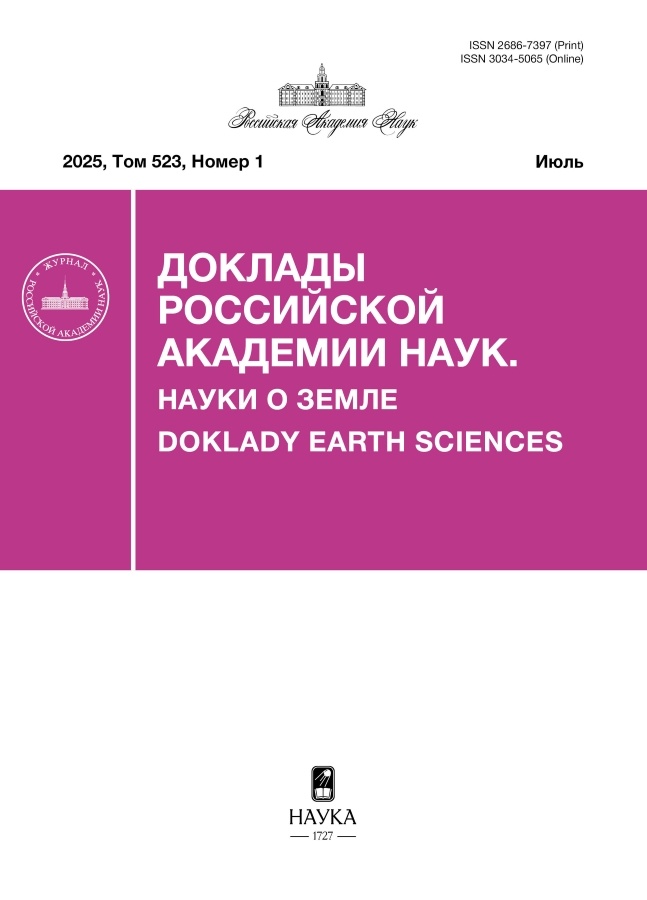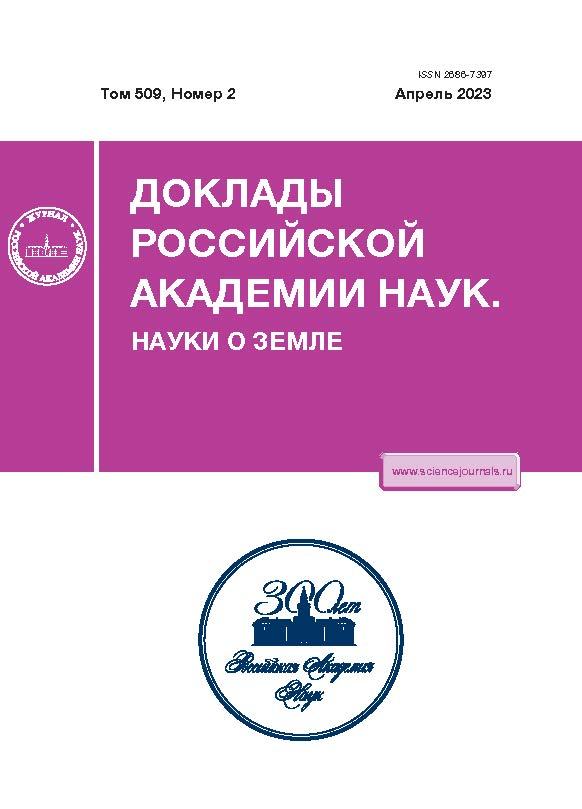Изотопные Sm‒Nd-характеристики ювенильной коры центральной части Монголо-Охотского орогенного пояса
- Авторы: Дриль С.И.1, Кузьмин М.И.1, Носкова Ю.В.1, Зарубина О.В.1
-
Учреждения:
- Институт геохимии им. А.П. Виноградова Сибирского отделения Российской академии наук
- Выпуск: Том 509, № 2 (2023)
- Страницы: 184-189
- Раздел: ГЕОХИМИЯ
- Статья получена: 30.01.2025
- Статья опубликована: 01.02.2023
- URL: https://vestnik.nvsu.ru/2686-7397/article/view/649684
- DOI: https://doi.org/10.31857/S2686739722602812
- EDN: https://elibrary.ru/NZHQLS
- ID: 649684
Цитировать
Полный текст
Аннотация
В фанерозойское время процессы формирования континентальной коры были связаны с конвергентными геодинамическими обстановками и, соответственно, с внутриконтинентальными орогенными поясами, возникавшими на месте закрывшихся палеоокеанов. Выяснение соотношения ювенильного и более древнего рециклированного вещества является важнейшим параметром, определяющим историю формирования коры орогенов. Монголо-Охотский орогенный пояс является одной из важнейших структур Центральной Азии. В его центральной – Забайкальской – части представлены наиболее полно сохранившиеся фрагменты островодужных комплексов, а также весь спектр образований его аккреционной призмы, что позволило провести оценку соотношения ювенильного и рециклированного осадочного материала в коре этого орогена. Наиболее представительными фрагментами ювенильной коры в этой части пояса являются вулканогенно-осадочные образования каменской и уртуйской свит позднепалеозойского возраста. Первая из них является индикатором зоны субдукции вдоль северо-западной окраины Монголо-Охотского палеоокеана с падением под Сибирский палеоконтинент, а вторая – вдоль юго‑восточной, с падением под Аргунский супертеррейн. Весь спектр вулканитов каменской свиты от базальтов до риолитов имеют положительные величины εNd(254МА) = +1.4–(+3.8) и TNd(DM) = 896–920 млн лет. Величины εNd(350МА) в базальтах уртуйской свиты так же положительны и лежат в пределах +1.7–(+6.0) при TNd(DM) = = 773–939 млн лет. Это позволяет определить характеристики ювенильной коры орогенного пояса, которая характеризуется положительными величинами εNd(t) и модельными возрастами TNd(DM) < < 1000 млн лет. В составе метаосадочных пород аккреционного клина Монголо-Охотского орогенного пояса существенно преобладает более древнее рециклированное коровое вещество, источником которого, вероятно, являются позднерифейские комплексы Аргунского супертеррейна.
Об авторах
С. И. Дриль
Институт геохимии им. А.П. Виноградова Сибирского отделения Российской академии наук
Автор, ответственный за переписку.
Email: sdril@igc.irk.ru
Россия, Иркутск
М. И. Кузьмин
Институт геохимии им. А.П. Виноградова Сибирского отделения Российской академии наук
Email: sdril@igc.irk.ru
Россия, Иркутск
Ю. В. Носкова
Институт геохимии им. А.П. Виноградова Сибирского отделения Российской академии наук
Email: sdril@igc.irk.ru
Россия, Иркутск
О. В. Зарубина
Институт геохимии им. А.П. Виноградова Сибирского отделения Российской академии наук
Email: sdril@igc.irk.ru
Россия, Иркутск
Список литературы
- Тейлор С.Р., Мак-Леннан С.М. Континентальная кора: ее состав и эволюция. М.: Мир, 1988. 384 с.
- Windley B. The evolving continents. 3rd edition. JohnWily & Sons. Chichester, 1995. 526 p.
- Коваленко В.И., Ярмолюк В.В., Ковач В.П. и др. Корообразующие магматические процессы при формировании Центрально-Азиатского складчатого пояса: Sm-Nd изотопные данные // Геотектоника. 1999. № 3. С. 21–41.
- Jahn B.M., Wu F.Y., Chen B. Massive granitoid generation in Central Asia: Nd isotope evidence and implication for continental growth in the Phanerozoic // Episodes. 2000. V. 23. № 2. P. 82–92.
- Jahn B.M. The Central Asian Orogenic Belt and growth of the continental crust in Phanerozoic // Geology Society. London. Special Publication. 2004. V. 226. P. 73–100.
- Kroner A., Kovach V., Alexeiev D., et al. No excessive crustal growth in the Central Asian Orogenic Belt: Further evidence from field relationships and isotopic data // Gondwana Research. 2017. V. 50. P. 135–166.
- Парфенов Л.М., Попеко Л.И., Томуртогоо О. Проблемы тектоники Монголо-Охотского складчатого пояса // Тихоокеанская Геология. 1999. Т. 18. № 5. С. 24–43.
- Парфенов Л.М., Берзин Н.А., Ханчук А.И. и др. Модель формирования орогенных поясов Центральной и Северо-Восточной Азии // Тихоокеанская геология. 2003. Т. 22. № 6. С. 7–41.
- Дриль С.И., Кузьмин М.И. Геохимия пород Береинской палеоостровной дуги в центральном секторе Монголо-Охотского складчатого пояса // ДАН. 1998. Т. 360. № 2. С. 241–245.
- Дриль С.И., Лохов И.К., Куриленко А.В. и др. Sr-Nd изотопно-геохимическая характеристика и U-Pb геохронология пород островодужных комплексов Монголо-Охотского складчатого пояса // Современные проблемы геохимии. Материалы Всероссийского совещания, посвященного 95-летию академика Л.В. Таусона. 22–26 октября 2012 г. Иркутск. Т. 2. С. 220–223.
- Churikova T., Dorendorf F., Worner G. Source and fluids in the mantle wedge below Kamchatka, evidence from across-arc geochemical variation // Journal of Petrology. 2001. V. 42. № 8. P. 1567–1593.
- McDonough W.F., Sun S.S. The composition of the Earth // Chemical Geology. 1995. V. 120. № 3–4. P. 223–253.
- Попеко Л.И. Карбон Монголо-Охотского орогенного пояса. Владивосток: Дальнаука, 2000. 124 с.
- Yang Y.-H., Chu Zh. Y., Wu F.-Y., et al. Precise and accurate determination of Sm, Nd concentrations and Nd isotopic compositions in geological samples by MC-ICP-MS // J. Anal. At. Spectrom. 2010. V. 26. P. 1237–1244.
- Голубев В.Н., Чернышев И.В., Котов А.Б. и др. Стрельцовский урановорудный район: изотопно-геохронологическая (U-Pb, Rb-Sr и Sm-Nd) характеристика гранитоидов и их место в истории формирования урановых месторождений // Геология Рудных Месторождений. 2010. Т. 52. № 6. С. 553–571.
- Смирнова Ю.Н., Овчинников Р.О., Смирнов Ю.В. и др. Источники кластического материала и условия накопления осадочных пород Даурской серии Аргунского континентального массива // Тихоокеанская геология. 2022. Т. 41. № 1. С. 13–31.
- Gordienko I.V. The role of island-arc oceanic, collisional and intraplate magmatism in the formation of continental crust of the Mongolia-Transbaikalia region: geostructural, geochronological and Sm-Nd isotope data // Geodynamics & Tectonophysics. 2021. V. 12 (1). P. 1–47.
- Булгатов А.Н., Климук В.С. Шивохин Е.А. Кулиндинская свита в стратотипе (Восточное Забайкалье, Монголо-Охотский складчатый пояс) // Отечественная геология. 2010. № 4. С. 54–60.
- Руженцев С.В., Некрасов Г.Е. Тектоника Агинской зоны (Монголо-Охотский пояс) // Геотектоника. 2009. № 1. С. 39–58.
- Wang T., Tong Y., Zhang L., et al. Phanerozoic granitoids in the central and eastern parts of Central Asia and their tectonic significance // Journal of Asian Earth Sciences. 2017. V. 145. P. 368–392.
Дополнительные файлы














